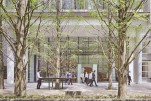We Are Glad to Everyone Who Would Like to Work in Our Team

Founded in 1900, the largest international architectural and engineering practice Nikken Sekkei is acclaimed all over the world. Its specialists develop and implement projects in different countries, creating a comfortable environment and a new image of many cities. But how to become a member of Nikken Sekkei’s team? Does the company engage graduates of architectural universities right after their graduation? What kind of talents should you possess to work in such a famous company? Our reporter discussed this and other questions with Tadao Kamei, the President and CEO of Nikken Sekkei, in the course of an exclusive interview at the company’s headquarters in Tokyo.
Mr. Tadao Kamei, I would like to ask you of how do graduated students can apply for work in Nikken Sekkei? I studied the process of applying for a job in your company and found out that you need not only to provide your CV and portfolio, but also to pass the exam. In Europe, it works in different way, so could you, please, tell us more about this?
I am well aware of the difference between Japanese and European systems of application in architectural companies, since I used to work at the HOK’s office in New York before coming to Nikken Sekkei. In Japan, shortly before graduation, students start sending their documents to architects’ offices or general contractor companies. General contractors in Japan normally have their own large architectural design departments. Therefore, students definitely should choose the direction they prefer to work in the future. They can send applications to our office annually before March, and the selection is made at the beginning of March. Only this month. In Europe or in the US, the time for filing documents is usually not clearly defined - you can do it at any time.
We ask students to send their application form, including the CV to get a first impression about their skills. Then we conduct a preliminary selection based on the CV and portfolio. Next, we hold an interview with a so-called «sketch solving problem». The task for it can be, for example, the following: a small house or an architectural studio in the suburbs. We ask students to design this kind of small project during 3 or 4 hours. They need to draw their idea in manual way. Thus, we can check how the students are able to cope with a given topic within a limited period of time, assess their drawing skills and, most importantly, their way of thinking.
Full content of this issue you can read here
The full version of the article can be read in our printed issue, also you can subscribe to the web-version of the magazine
 Interviewed by ELIZAVETA KLEPANOVA
Interviewed by ELIZAVETA KLEPANOVA


